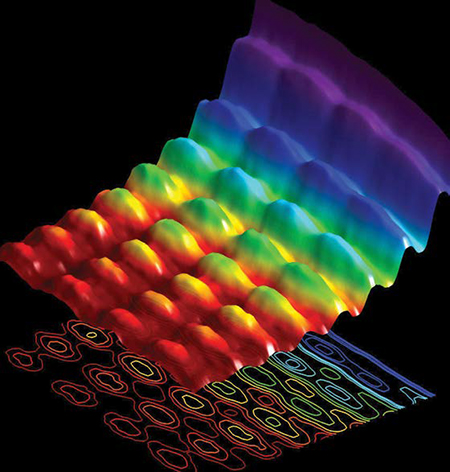Exploring the True Beauty of Light Itself
For nearly two decades I’ve been writing about cinematography and lighting, and I’ve never just taken a few minutes to write about light itself. I was inspired by an episode of “Cosmos” with the extraordinary Neil deGrasse Tyson, and further prodded by an Instagram post that I made last month with a photo from École polytechnique fédérale de Lausanne (EPFL), a European technical university.
The photo is the result of a collaboration between the Laboratory for Ultrafast Microscopy and Electron Scattering of EPFL, the Department of Physics of Trinity College in the United States and the Physical and Life Sciences Directorate of the Lawrence Livermore National Laboratory. It is the first time in history a photograph has been taken of light simultaneously behaving as a wave and as a particle.

A photograph of light simultaneously behaving as a wave and as a particle.WAVE AND PARTICLE
In 1905 Albert Einstein was the first to propose that light had a duality to it, behaving both as a wave and as a particle, and countless scientific experiments have proven one or the other to be true. But never before has anyone captured the true duality of light simultaneously, until just this March. The picture generated by EPFL is so perfect in its pure scientific beauty (yeah I’m not gonna lie... I geeked out for quite awhile when I first saw this picture).
Light, itself, is truly extraordinary. It is only a tiny sliver of the otherwise massive electromagnetic spectrum; about 400 to 700 nanometers (one billionth of a meter) is the spectrum we call “light.”
I’ve spent the vast majority of my life centrally preoccupied with this beautiful phenomenon. It is light that brings out the beauty in our world: a stunning golden sunset over a turquoise tropical sea; the nearly iridescent blue of a lotus flower; the fiery green eyes of the one that you love. We can only experience these wonders through the phenomenon of light.
There is nothing else in our universe that behaves like light. A photon of light is born instantly, traveling at 186,000 miles per second. There is no acceleration, just instantaneous speed; a speed that nothing in our known world can even come close to matching.
I’m certainly not the only one who spent a lifetime obsessing over light. It was the polymath Ibn al-Haytham (965–1040 CE) who shucked conventional wisdom and noted that light is emitted from light-producing sources (such as the sun and fire) and reflected off objects in our world before reaching our eyes. Up until that point, conventional wisdom stated that our eyes sent out rays that reflected off objects and returned to us. He also was the first to note that light travels in a straight line—somewhat ironic to our typical subjects here, he discovered this by creating a camera obscura.
Sir Issac Newton (1642–1727) was the first to propose a particle nature to light, which he dubbed “corpuscular,” and the first to identify that white light is actually composed of the entire spectrum of colors (principally red, orange, yellow, green, blue, indigo and violet). It is the light of the stars in the sky that has unlocked the secrets of the universe and the birth of existence as we know it.
Obviously, my love affair with light hasn’t always been academic; it started long before I even understood the concept of photography. I fell in love with light before I even quite understood that it was light that awakened a passion in me as a very young child. This true romance started in the darkened cinema; watching light dance on the movie screen and bring pure imagination to life.
GETTING LOST IN LIGHT
In the intro to my first book “A Shot in the Dark,” I wrote about how I used to drive my wife nuts by getting lost in light on a constant basis. We’d be in a restaurant, having a casual conversation and suddenly she would stop and look at me and say, “you’re looking at the lighting again, aren’t you?” Yup! I sure was.
Once I graduated from the simple idea of light as a utility into the world of light as an artistic expression (this transition was aided considerably by the brilliant lighting designer Ed Brown, whom I worked with for a number of years), I began to see light completely differently. I began to notice how the sun reflected off the windows of the buildings in the late afternoon. I would sit for hours in my first apartment in Los Angeles and watch as the light changed over the course of the day.
For me, every one of these experiences went into a mental Rolodex of imagery that I would consult any time I had to create a moment with light. Every scene that I’ve ever lit has been inspired by some observation or memory from real life; from that “mental Rolodex.”
I try to inspire my students and readers to venture forth and do the same. Learn to see light as it happens around you. Take the time to watch that glorious sunset. Take the time to watch as that sunbeam slowly inches across the room on a lazy winter afternoon. Take the time to see the rainbow created inside a dew drop on a blade of grass. As technicians, sometimes our trade can be relegated to a “2K” here or a “1x1” there or just another “Leko” in the corner. Work to see beyond the mundane technical details of our vocation and revel in the true beauty of light—artificial just as much as natural. It’s all truly awe-inspiring.
Jay Holben is the author of the book “A Shot in the Dark: A Creative DIY Guide to Digital Video Lighting on (Almost) No Budget.” He can be contacted via TV Technology.
Get the TV Tech Newsletter
The professional video industry's #1 source for news, trends and product and tech information. Sign up below.
